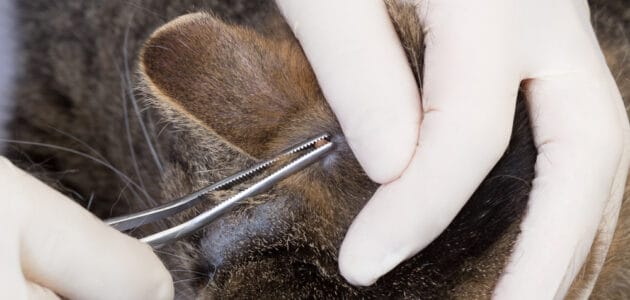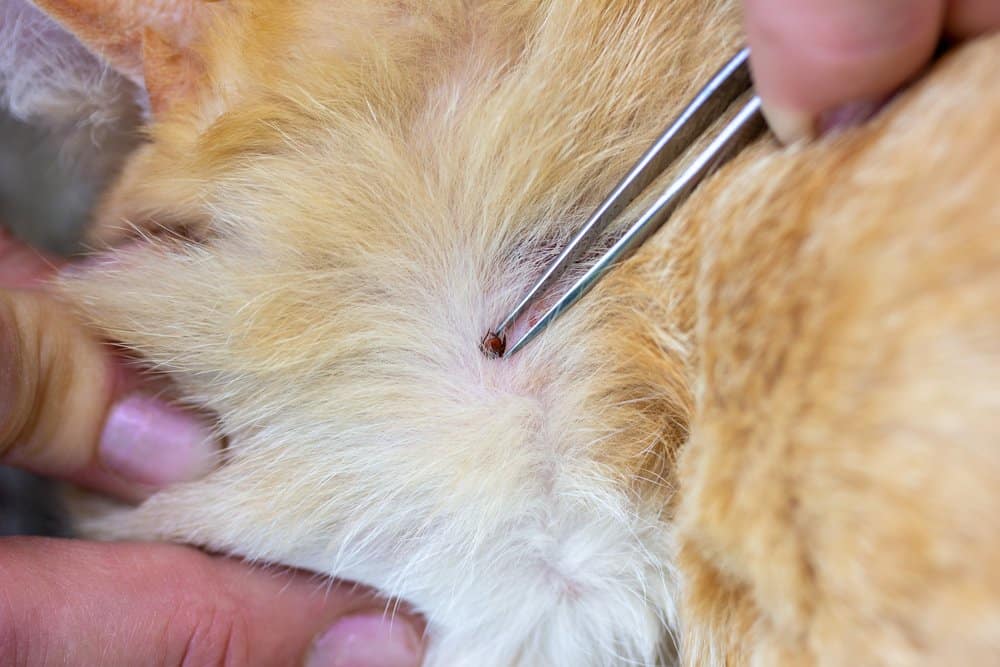How to Remove a Tick From a Cat

Cats are wonderful creatures, but sometimes they can bring unwanted guests into your house, like dead mice, half-dead birds, and worst of all, completely-alive ticks.
Ticks are disgusting, repulsive creatures — and they can also be dangerous to both you and your cat, so it’s essential to take care of the problem as soon as you can.
Getting rid of a tick isn’t just as simple as grabbing it and pulling it off, though. If you do that, you could end up making things worse. There’s a very specific way you should go about removing the little goblin.
Below, we’ll show you exactly how to get that revolting creepy-crawly off your cat so that you can both rest a little easier at night.
What Exactly Are Ticks, Anyway?
Ticks are parasitic arachnids — which is a fancy way of calling them “vampire spiders.” They latch on to all sorts of other animals — including birds, reptiles, and amphibians — and they feast on their blood, growing fat in the process.
These creatures are actually quite old, dating back to the late Cretaceous period some 120 million years ago. They’ve survived in large part because they’re incredibly simple creatures — they’re basically just a mouth with legs and a digestive tract.
That’s not to say that they don’t have sophisticated parts and pieces, though. Their legs have a sensory structure known as Haller’s organ that allows them to detect odors, chemicals, and even infrared light emanating from a host. That means that, if you’re in the vicinity of a tick, they’ll know — and they’ll try to chomp on you. They can’t fly or jump, though, so they’ll have to wait for you to brush up next to them.
Some ticks latch on to the first area they come in contact with, while others look for areas with thinner skin, like ears. Once they find a suitable spot, they cut a hole in the skin and start to slurp down as much blood as they can. They even excrete a chemical that stops the blood from clotting.
Most ticks will stay attached until they become fully engorged. Their weight can increase anywhere from 200 to 600 times after feeding, and once they’re finally full, they’ll simply fall off. Once off, they’ll lie in wait for their host to return to provide them with their next meal whenever they get hungry again.
Are Ticks Dangerous?
In most cases, tick bites are harmless. The host usually doesn’t even notice they’re there — it would be bad for business if they were discovered, after all.
However, some animals are allergic to tick bites. Getting bitten can cause pain and swelling, blisters, and even difficulty breathing. If you notice your cat struggling to breathe, take them to the vet immediately.
The biggest worry with a tick bite, though, are illnesses, like Lyme disease and Rocky Mountain spotted fever. These can be quite serious and even deadly, so if your cat starts acting lethargic, bleeding from the mouth or anus, or running a fever, take them to the emergency clinic.
Oh, and humans can get (and die from) those illnesses as well, so monitor your own health while you’re at it.
How to Keep Ticks From Latching on to Your Cat in the First Place
As you’ve likely heard a few thousand times before, an ounce of prevention is worth a pound of cure — and that’s true for treating ticks on cats as well. It’s much better to avoid letting the little bloodsuckers latch on to your cat than it is to remove them after the fact — especially if you let your cat come in the house after being outside.
Keep Your Cat Inside
Speaking of which, the best way to keep ticks off your cat is to never let them wander outside in the first place. If your cat never goes outside, there’s almost no chance that they’ll ever come in contact with ticks. They’ll also likely live much longer — as much as three times longer, in fact.
Use Tick-Prevention Treatments on Your Cat
If you do decide to let your cat roam around outside, make sure they have some sort of flea and tick prevention on first. You can use oral medications, collars, spot treatments, or some combination of the three.
Spot treatments and oral medications tend to be the most effective, but the important thing is to not let your cat wander around unprotected. Make sure to talk with your vet about which kind of treatment would work best for your cat.
Use Tick-Prevention Treatments on Your Yard
You can also treat your yard and surrounding areas. You can find sprays and granular treatments that allow you to treat large areas such as your lawn or bushes. These aren’t completely effective, but they can at least diminish the tick population and reduce the likelihood that your cat will get bit.
How to Safely Remove a Tick From Your Cat

You should check your cat for ticks every time they come in from outside, or at least once a day. The most common areas you’ll find ticks are their ears, head, paws, and around the tail.
If you spot one, you’ll need to remove it. The good news is that if you spot the tick soon enough, there’s little risk of it transmitting Lyme disease to your cat. In most cases, it takes 36 – 48 hours for these disease-causing microbes to be transmitted to your cat. However, other diseases may be transmitted after 12-24 hours.
Still, that means that time is of the essence. Here’s what you need to do to make the removal process successful.
Gather Your Tools
There are a few things you’ll need before you get started. Here are the tools you should have on hand:
- A partner to help hold the cat
- Gloves
- Tweezers or a tick-removing tool
- Antiseptic
- Disinfectant for the tweezers
- Something to kill and dispose of the tick with (rubbing alcohol, a Ziploc bag, and a working toilet are all good options)
- Treats (for the cat, not the tick)
All of these items are essential, so don’t get started until you’re suitably equipped.
Removing the Tick
Have your partner hold the cat and restrain them. They don’t need to put a death grip on the cat, but they need to keep the cat from scratching or biting you during the procedure. It helps to distract the cat with a treat, so have something they really enjoy on hand, like tuna.
- Put the gloves on before you get started. Humans can be affected by tick-borne diseases as well, so you don’t want to get bitten. More importantly, though, you don’t want to get any tick juice on you if the thing pops.
- Separate your cat’s fur so that you can get a clear look at the tick, then take the tweezers and grab the tick as close to your cat’s skin as you can. Try not to squeeze it, though, as you definitely don’t want it to burst. Not only is that gross, but it can also force parts of the dead tick into your cat’s body.
- Once you get a good grasp on the bug, pull up with firm, gentle pressure. It shouldn’t take much to convince the tick to let go, so there’s no need to be aggressive.
- The tick should pop off after a few moments. Rub some antiseptic or antibiotic ointment on your cat to make sure the area doesn’t get infected, and disinfect your tools as well.
Getting Rid of the Tick
Once you have the tick removed, it’s time to finish the job. The best way to do this is by dropping it into a container full of isopropyl alcohol. Not only will this kill the thing, but it also lets you save the body in case you need to get it tested for diseases later.
You can also put it in a Ziploc bag and seal it. The bug will eventually suffocate, and you’ll still have the body on hand (and in a convenient plastic coffin to boot).
If neither of those options appeal to you, you can simply flush it down the toilet. This is somewhat controversial, as many experts will recommend that you keep the body on hand for a few weeks in case your cat gets sick. However, it’s unlikely that your pet would contract a disease from a tick bite, and very few houseguests are impressed by tick taxidermy.
Of course, the most important thing to do after you kill the tick is to look at it and say something like, “Looks like we finally found what makes you tick.” Try to make sure someone hears you say it, too (you may need to repeat it a few times).
What Not to Do
There are a variety of myths and old wives’ tales around tick removal. You might have heard some of them, but many of these are ineffective at best and potentially dangerous at worst.
Don’t Try to Suffocate the Tick While It’s on Your Cat
Many people recommend putting nail polish remover, Vaseline, or alcohol on the tick while it’s still attached, as they believe it will cause the tick to suffocate and fall off on its own.
Does it work? Maybe — but it takes a long time, during which your cat could be exposed to disease-causing microbes.Also, just because it fell off doesn’t mean it’s dead — it could be hiding somewhere in your house.
Don’t Keep Trying if the Tick Doesn’t Easily Come Off
Don’t twist, squeeze, or yank on the tick, and stop if your cat seems to be in pain. Not all ticks can be safely removed with tweezers, so if it doesn’t come off easily, you should let your vet handle it.
Don’t Burn the Tick off With a Match
You may also have heard that you should burn the tick off with a match. This is really, really bad advice. Not only is it a bad idea to come after your cat with fire in your hands, but even if you can get them to sit still around the match, the heat may cause the tick to rupture.
While an exploding tick might sound awesome in theory, it’s much less fun in practice — especially if it involves wiping tick guts off your face.
Don’t Leave the Tick Alive
Don’t throw it in the trash without killing it or drop it in the toilet without flushing it, either. If you leave them alive, they could crawl out and come looking for another meal. That meal could be your cat — or it could be you.
What if the Head Remains Attached?
Sometimes things just go wrong. Despite your best efforts, the tick’s head could remain embedded in your cat’s skin even after its body has been ripped off. While this clearly isn’t ideal, there’s no reason to panic.
The good news is that the tick is dead and no longer at risk of transmitting any diseases to your cat. Your kitty could still develop an infection around the head, though.
Don’t try to remove the head yourself. You’ll likely just do more damage to your cat’s skin, increasing the risk of infection. Your cat’s body will naturally expel the head itself after a few days.
All you need to do is clean and disinfect the area, and then keep an eye on it until the head falls out. Chances are the situation will clear itself up on its own, but if you notice a rash developing around the head, it’s time to take your cat to the vet.
The Aftermath: Taking Care of Your Cat After Removal
You may think you’re in the clear after all parts and pieces of the tick have been removed from your cat, but that’s not necessarily the case. There’s still the risk that they could have caught some sort of disease from the tick.
As a result, you’ll need to keep an eye on them for the next few weeks. Check the bite site regularly to make sure it’s not inflamed or irritated, and watch out for any signs that your cat is acting abnormal or ill.
You should also be on the lookout for symptoms like:
- Fever
- Lethargy
- Diminished appetite
- Painful stiffness and swelling in muscles and joints
If you notice any of the above symptoms, take your cat to the vet immediately. Lyme disease can be treated in cats, but you need to take action promptly. The longer you wait, the more likely it is that your cat will suffer irreversible tissue damage.
Final Thoughts
If you let your cat wander around outside, then there’s a good chance that, sooner or later, they’ll come home with a tick attached. While that’s certainly not ideal, it’s not the end of the world, either — provided you remove the tick quickly and correctly.
Fortunately, it’s fairly easy to do, and once you get the hang of it you might even enjoy killing the little creeps. That’s what they get for coming after your cat — not that your ungrateful cat will ever thank you, of course.




